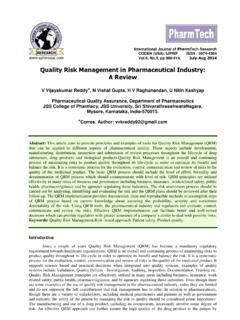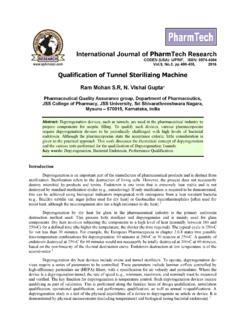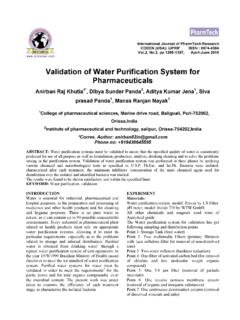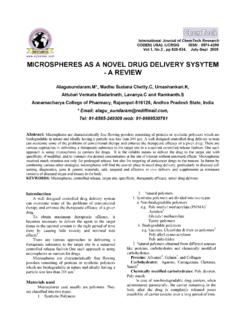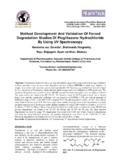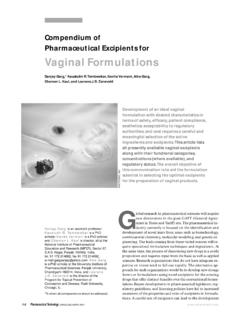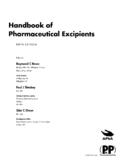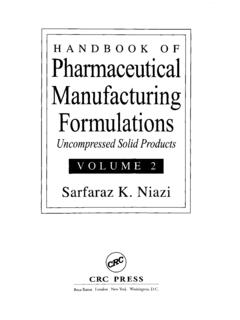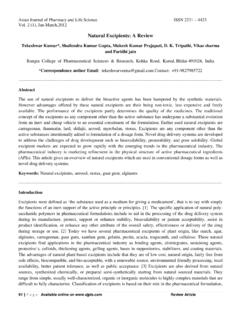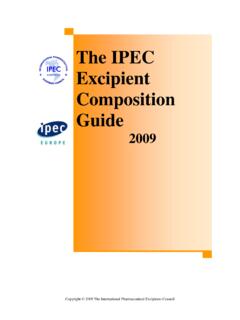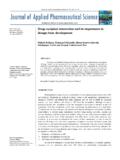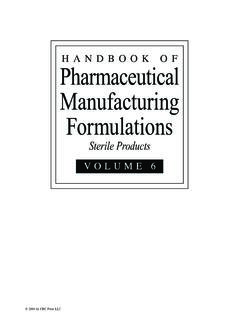Transcription of Poloxamers: A pharmaceutical excipients with …
1 International Journal of PharmTech Research CODEN( USA): IJPRIF ISSN : 0974-4304 , , pp 299-303 , April-June 2009 Poloxamers: a pharmaceutical excipients with therapeutic behaviors Hitesh R. Patel1*, Rakesh P. Patel1, Patel2. 1 Dept. of Pharmaceutics and pharmaceutical Technology, College of Pharm.
2 Edu. and Research, Ganpat University, Kherva-382711, Gujarat, India. 2 Principal, Kalol institute of technology, Kalol, Gujarat, India E-mail : Abstract: The effect of excipients for synergistic effect or any combinational therapy is became a one of the best alternative for the dosage form development in the current research. Here we have reviewed on the different category of poloxamers as novel polymer for the drug delivery. Apart from the very good excipient properties, poloxamers showed a clinical and therapeutic uses for cure and treatment of various physiological condition.
3 It is used in the various DNA technology, brain injury, cardiovascular, microbiological, burn injury and ophthalmic treatment also. The goal of this review is to improve the used of poloxamers to achieved economic treatment with less side effect. Key words: Poloxamers, Copolymers, pharmaceutical ingredient, therapeutic effect 1. Introduction: Poloxamers are non-ionic poly (ethylene oxide) (PEO) poly (propylene oxide) (PPO) copolymers. They are used in pharmaceutical formulations as surfactants, emulsifying agents, solubilizing agent, dispersing agents, and in vivo absorbance enhancer 1.
4 Poloxamers are often considered as functional excipients because they are essential components, and play an important role in the formulation2. Poloxamers are synthetic triblock copolymers with the following formula: All poloxamers have similar chemical structures but with different molecular weights and composition of the hydrophilic PEO block (a) and hydrophobic PPO block (b). Two of the most commonly used poloxamers are poloxamer 188 (a=80, b=27) with molecular weight ranging from 7680 to 9510 Da, and poloxamer 407 (a=101, b=56) with molecular weight ranging from 9840 to 14600 Da.
5 Despite their wide range of applications, limited analytical techniques have been reported in literature for characterizing poloxamers and few are targeted to quantify poloxamer contents in formulations with desired sensitivity and accuracy. poloxamer is available in different grade based on the physical parameter like Molecular Weight, Weight % of oxyethylene etc. The common available grades are poloxamer (68, 88, 98, 108, 124, 188, 237, 338, and 407) 3 . Their surfactant property has been useful in detergency, dispersion, stabilization, foaming, and emulsification4.
6 Some of these polymers have been considered for various cardiovascular applications, as well as in sickle cell anemia. Two polymers from this class, poloxamer 188 and poloxamer 407, show inverse thermosensitivity; therefore, they are soluble in aqueous solutions at low temperature, but will gel at higher temperature 5. 2. Poloxamers as pharmaceutical excipients Poloxamers possesses properties which appear to make it suitable for use in the formulation of topical dosage forms. poloxamer 407 had been used in vehicles for fluorinated dentifrices, eye applications and contraceptive gels.
7 A poloxamer based dental gel product has been in use several years for treating patients with sensitive gums and teeth. Moreover, P-407 gel has been shown to possess many favorable characteristics for use as a burn dressing. Not only does the gel provide a non-toxic Hitesh R. Patel et al PharmTech ,1(2) 300 detergent covering to the wound, but specific studies suggest that the pluronic gel itself may have a beneficial action, accelerating wound healing over controls6.
8 This makes P-407 a very suitable vehicle for gels intended to be applied for ulcers and traumatic lesions. For example, the formulation of conventional suppository, a polyethylene glycol (PEG)-based suppository, which may softens or melts lately in the rectum due to its relatively high melting point, can not be rapidly absorbed in the rectal mucous membranes. Furthermore, such a PEG-based suppository, which may reach the end of the colon, has a loss of drug at colonic level and may also allow the carried drugs to undergo the first-pass effect.
9 In this study, as a base of novel poloxamer -based suppository, a mixture of poloxamer 124 (P 124) and poloxamer 188 (P 188) with the melting point of about 15 and 55 C, respectively, has been selected. In addition, P 124 and P 188 are known to have suitable mucoadhesive force, low toxicity, less skin irritation, good drug release characteristics and compatibility with other chemicals7 . Apart from this so many activities of poloxamer as formulation excipients , here we have planned to review the specific use of poloxamer in treatment of some disease state and as an alternative substitute for the therapy.
10 3. Important clinical applications of Poloxamers in different field Biotechnological activity poloxamer hydrogel is used for the assessment of bio film susceptibility towards biocide treatments. Here for this type of activity a Chilled poloxamer was mixed with an inoculum of Pseudomonas aeruginosa and placed as 100 l drops onto separate glass cover-slips. These were placed into sealed Petri dishes containing moistened cotton wool and incubated at 35 C. SDS-PAGE of cell envelope preparations showed the poloxamer -grown cells to exhibit a biofilm rather than planktonic phenotype.
